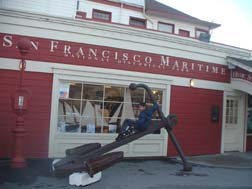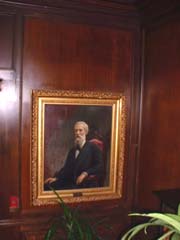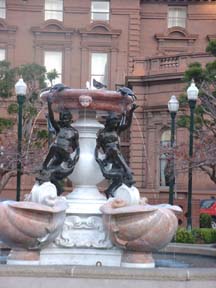A Million Dollar Tour of San Francisco for $6

Child plays on an anchor at entrance to the Hyde Street Pier.
By Graceann Walden
Published: January, 2002
In these weird economic times, we’re all looking for affordable entertainment. It can be had by ferry riders for a mere $6. Take your friends, family and visitors on an insider’s tour of three great San Francisco neighborhoods: Chinatown, nob Hill and Fishermen’s Wharf.
As a writer specializing in the Bay Area food scene, I try to keep my readers in the know and when I wear my other hat, as a tour operator, I like nothing better than taking locals and visitors on adventures through our terrific neighborhoods.
Here’s an idea for a great way to spend a self-guided fun and educational afternoon. Leaving the Ferry Terminal, proceed across the beautiful new plaza that spans the length of the Ferry Building, now being expanded and retrofitted. If you need a cup of coffee to fuel your odyssey, there is a Noah’s Bagel shop on Market Street on the ground floor of the Hyatt Regency Hotel.
Board a Van Ness and California Street cable car in front of the Hyatt Regency Hotel, at the foot of California Street and Main. Pay the conductor for an all-day MUNI pass - $6.* The cable cars run every 15 minutes from 6:22am until 1am, although we don’t recommend this tour as a late night jaunt.
If you sit on the right side of the cable car, or hang off that side, you get the better view of our trip up California Street. Along the way you’ll pass the venerable Tadich Grill, the rainy day restaurant where the sautéed sand dabs are always a good choice. Almost directly next door is another restaurant specializing in seafood, Aqua. One dish that has become a signature there is the mussel soufflé.
Your trip will take you next past the buildings that house the leading financial institutions of San Francisco: the classically designed California Bank of Trust, the beautiful Merchants Exchange Building and the massive Bank of America building.
Alight from the cable car at Grant Avenue at California for a stroll through Chinatown. But first take the time to make a short visit to Old St. Mary’s -the first Roman Catholic Cathedral in California. Chinese laborers built this gothic revival church using stone quarried in China and bricks brought around the horn. The first English-language school for the Chinese community was founded here.
In contrast to Old St. Mary’s two buildings, the Sing Chong and Sing Fat buildings built in 1908, flank the north side of California. Both display Chinese architectural elements, upturned roof edges, pagoda ornamentation and tiling prevalent throughout Chinatown. The upturned roof edge is not just an element of style, but meant to dissuade evil spirits from landing on the building.
Across California Street, be sure to visit St. Mary’s Square, to see the statue of Sun Yat Sen, by San Francisco’s favorite sculptor, Beniamino Bufano.
Strolling down Grant, in the first block east of California you’ll find the old-timey Far East Café, known for its food and even more for its interior featuring high-backed and curtained booths. In the same block two of the best places to buy inexpensive all-manner of trinkets, back-scratchers, statues and toys are the Canton Bazaar and across the street the China Bazaar.
Since Grant Avenue is geared towards the tourist trade souvenir, linen and jewelry stores, as well as restaurants dominate the scene. A few places deserve special mention. The Empress of China restaurant, between Clay and Washington Streets, perches high above the busy streets below. And, although it is not trendy, serving a menu of Chinese American fare, it is one of the most pleasant white tablecloth Chinese restaurants in Chinatown.
Unlike the cafes that surround it on the busy streets below, the Empress has a full bar and a spectacular 180 degree view of the Bay. In the lobby, near the elevators, that you must take to reach the restaurant, you can look at a display of photos of dignitaries, who have dined at the Empress. You’ll see pics of Lana Turner, Barbara Bush, Vincent Price and a rare photo of James Beard and Craig Claiborne dining together.
On Grant between Washington and Jackson Street, there are several other interesting places. The Buddha Bar is one of the funkiest and fun bars in Chinatown. Nearby, Chew Chong Tai & Co. sells kits for brush painting, decorative calligraphy scrolls and delicate Chinese brush paintings.
One fun thing to do is to have Mr. Li, who works at Chew Chong Tai, do a scroll on the spot. It makes a unique birthday gift. The lady behind the counter will look up any name in a special English to Chinese dictionary and copy the characters for Mr. Li. For a few dollars, Mr. Li produces a handsome brush painting of the name.
If you’re getting hungry, the Kowloon Café is next door. An incense-laden Buddha watches over the utilitarian dining room, where you can get yummy vegetarian dim sum to go, or enjoy their buffet lunch. Their vegetarian version of sui mai is so good, you won’t miss the pork.
If you want to learn something about Chinese teas, Ten Ren Tea Co. is a good place to stop. Located close to Jackson Street, the store has scores of green, black and aged teas. A new addition to the shop is a "tea bar" serving flavored tea drinks, hot tea and goopy tapioca drinks – currently all the rage. They’re flavored-sweetened liquid with balls of tapioca suspended in it. It’s partly drunk and eaten.
Across the street and down the block, is the best place in San Francisco to buy implements for Chinese cooking. Ginn Wall Hardware store has all manner of rice cookers, cleavers, woks, ginger craters, cookbooks, steamers, pots, pans and of course, hardware.
At Pacific, turn left from Grant to walk a hill to Stockton Street. It’s time to return to the California cable car, but instead of retracing your steps. Let’s explore the non-touristy part of Chinatown. Stockton Street is where Asians from all over the Bay Area flock to buy their meats, fresh fish, vegetables, and dry goods.
At the corner of Pacific and Stockton, Hop Sang Meat Market carries all manner of beef, pork, lamb and goat and also makes and packages their own beef or pork jerky. It comes in either spicy or regular and is $8 for half a pound - a chewy and delicious snack.
When you reach the Stockton Street tunnel, climb the stairs one flight to California Street, to re-board the cable car. Hang on, as the car climbs Nob Hill and get off at Taylor Street. Once dubbed the "hill of palaces" because of the mansions built there by the men who made their money in the wild boom days of early San Francisco, when silver and gold flowed from the mines and the Transcontinental Railroad linked our east and west coasts.
Grace Cathedral, the second largest Episcopal cathedral in the country, is located on the corner of Taylor and California Streets, on land donated by the Crocker family. Interestingly, although it looks like it has always been there, the cathedral, designed in the style of Chartres in France, was not completed until the 1960s.
Colorful murals, depicting the history of both California and the Episcopal Church in California line the sidewalls of the church. Above the murals, stained glass windows depict stories from the Bible as well as the saints. But above the long stained glass windows, there are a series of smaller windows called Human Endeavor. Some of the prominent historical figures depicted are President Franklin Delano Roosevelt, Albert Einstein and Luther Burbank.
Both inside the Cathedral and outside, meditative labyrinths grace the floors. The idea is to walk the labyrinths and to use them as a tool for contemplation. Also outside are the famous copies of the Renaissance artist Lorenzo Ghiberti’s "The Doors of Paradise." The bronze doors depict scenes from the Old Testament.
A short walk across Taylor brings you to Huntington Park, carved from land donated by Arabella Huntington, the widow of Collis P. Huntington, one of the Big Four railroad magnates. A nice playground with swings and slides at the north end of the park is fun for the little ones. Another draw is the fountain of the "Dancing Sprites" as well as the "Fountain of Turtles." The former Flood Mansion, built from sandstone, houses the Pacific Union Club, the private digs of San Francisco’s movers and shakers.
On the streets ringing the Pacific Union Club are some of the city’s poshest hotels: the Fairmont, Huntington Hotel and the Mark Hopkins. A short walk down California Street is where you’ll find the Stanford Court and also the Ritz-Carlton hotels. Tea at the Top of the Mark, with its awesome view of downtown and the Bay is worth doing. Across the street in the multi-million dollar refurbished Fairmont, the three-course luncheon buffet, served every day in the Laurel Court, is a terrific bargain at $19.95.
But if you really want to get into the spirit of the 19th century, stop by the Big 4 restaurant located in the Huntington Hotel. The décor will make you feel as if you have been transported to a fine salon, during the era of the railroad barons. The restaurant is graced with palms, enrobed in dark wood and leather and contains many prints, painting and photos of historic San Francisco, the railroads and the Big Four, themselves. Enticing dishes on the lunch and bar menu are a chicken potpie topped with puff pastry, buffalo chili, Cobb salad and lighter spa choices.
To continue your journey, walk down California Street to Powell and board a Hyde Street cable car for the Wharf. The cable car will wend its way through Russian Hill, passing the cars queued up to traverse, Lombard, the crookedest street. One of the most thrilling parts of the trip is zooming down the steep slopes of Hyde Street, to the terminal at the foot of Hyde. Alighting from the car,you’re at the apex of both Ghirardelli Square and the Cannery mixed use shopping and dining venues.
For a taste of history, walk down Hyde Street to Jefferson Street, to the Hyde Street Pier. The Pier is especially fun for kids, who can explore a 19th century sailing vessel and learn about our long seafaring heritage. There is an admission charge.
Down the block on Jefferson, one of the best places to buy crab in-season, live lobster and fresh and smoked fish is Alioto Lazio. This woman-owned business sells live crab and lobster from pristine tanks or cooked and cracked crab ready for your table.
Further down Jefferson, again on the Bay-side, Coast Marine & Supply is a serious store selling all manner of nautical tools, parts and heavy rope. But for landlubbers, Coast is also a great place to buy sturdy Russell fish knives - just right for filleting your catch or turning a whole fish into steaks.
Across the street, In & Out Burger has been a hit from day one. This family-owned chain makes a good priced burger and even yummier shakes.
Back on the Bay side, at Lou’s Pier 47 Café, blues bands play every day of the week and on Sunday afternoons. There is a small cover charge and full bar, plus a casual restaurant downstairs.
Even if you don’t go upstairs to Lou’s, be sure to make a right at that corner and stroll down Pier 47, to Scoma’s Restaurant. From the end of the pier, you can get a bird’s-eye view of Scoma’s fishing boat, when it’s in port, plus other fishing boats, rigged for crab or salmon, depending on the season.
Back on Jefferson Street, you’ll pass more fishing boats. In slow times, idle fishermen make their boats available for informal one-hour Bay cruises for $10 a head.
Continuing along Jefferson, you’ll pass lots of souvenir shops, hawking all manner of t-shirts and other items. At Jefferson and Taylor there are several dining choices from the Rainforest Café to the classy A Sabella’s to the historic Alioto’s No. 8.
Exhausted from your whirlwind tour, you’ll welcome the sight of the historic trolley cars of the F Line. On March 4th, 2000, after seven years of construction, the long-awaited direct rail link between Downtown and the Fisherman’s Wharf area debuted. The F-historic streetcar line wends its way from Market and Castro Streets, through the Downtown area and along the Northern Waterfront all the way to Fisherman’s Wharf at Jones & Beach Streets.
Hop on an historic streetcar for the scenic ride back to the Ferry Building or if you have any energy reserves take the car to the Downtown shopping district or all the way to Market and Castro, for more adventures.

Portrait of Mark Hopkins in the Big 4 restaurant in the Huntington Hotel on Nob Hill

Fountain of the Dancing Sprites on Nob Hill

